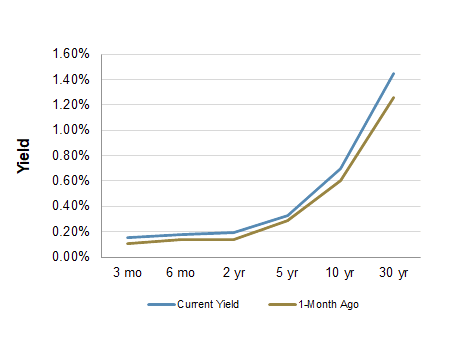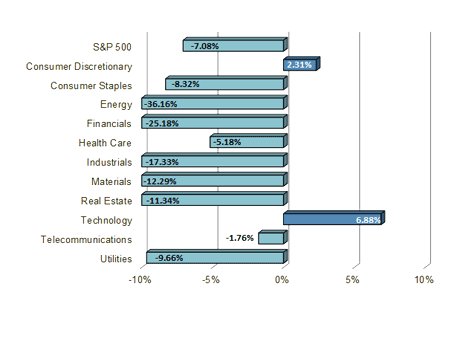Chief Economist Scott Brown discusses the latest market data.
The Federal Open Market Committee left short-term interest rates unchanged following its June 9-10 policy meeting and kept its asset purchase plans in place. The Fed released revised projections of growth, unemployment and inflation (after it had refrained from doing so in March). Officials expect a gradual economic recovery and saw no change in interest rates through 2022 – an outlook similar to that of most private-sector economists, but disappointing for financial market participants. In his press conference, Chair Powell indicated that the Fed was focused on the job market and was not looking to raise rates anytime soon, adding “we’re not even thinking about thinking about raising rates.” He said that the Fed would not tighten policy to deflate a possible asset bubble.
The National Bureau of Economic Research (NBER) declared that the economy entered a recession in February. Normally, the NBER waits many months before making such a declaration, but the magnitude of the decline in activity left no doubt. Economic data for May suggest that the recession may have ended in April, although a full recovery is expected to take many quarters.
As anticipated, the May inflation data were mild, reflecting weakness in demand due to social distancing. Jobless claims continued to trend lower, although the level remained extremely high.
Next week, two key economic reports will be released on Tuesday. Retail sales and industrial production are expected to post strong gains in May, following sharp declines in March and April (still leaving activity far short of where we were in February). Fed Chair Powell will present his semiannual monetary testimony to Congress on Tuesday and Wednesday (a month earlier than usual). There isn’t much suspense. We heard from him immediately after the FOMC meeting and we have the Fed’s revised forecasts in hand.
Indices
| Last | Last Week | YTD return % | |
|---|---|---|---|
| DJIA | 25128.17 | 26281.82 | -11.95% |
| NASDAQ | 9492.73 | 9615.81 | 5.80% |
| S&P 500 | 3002.10 | 3112.35 | -7.08% |
| MSCI EAFE | 1789.20 | 1820.35 | -12.16% |
| Russell 2000 | 1356.22 | 1452.06 | -18.71% |
Consumer Money Rates
| Last | 1 year ago | |
|---|---|---|
| Prime Rate | 3.25 | 5.50 |
| Fed Funds | 0.00 | 2.36 |
| 30-year mortgage | 2.94 | 3.92 |
Currencies
| Last | 1 year ago | |
|---|---|---|
| Dollars per British Pound | 1.260 | 1.269 |
| Dollars per Euro | 1.130 | 1.129 |
| Japanese Yen per Dollar | 106.87 | 108.50 |
| Canadian Dollars per Dollar | 1.363 | 1.334 |
| Mexican Peso per Dollar | 22.768 | 19.171 |
Commodities
| Last | 1 year ago | |
|---|---|---|
| Crude Oil | 36.34 | 51.14 |
| Gold | 1739.80 | 1336.80 |
Bond Rates
| Last | 1 month ago | |
|---|---|---|
| 2-year treasury | 0.19 | 0.14 |
| 10-year treasury | 0.70 | 0.60 |
| 10-year municipal (TEY) | 1.26 | 1.64 |
Treasury Yield Curve – 06/12/2020

As of close of business 06/11/2020
S&P Sector Performance (YTD) – 06/12/2020

Economic Calendar
| June 16 | — | Retail Sales (May) |
| — | Industrial Production | |
| — | Homebuilder Sentiment (June) | |
| — | Powell Monetary Policy Testimony (Senate) | |
| June 17 | — | Building Permits, Housing Starts (May) |
| — | Powell Monetary Policy Testimony (House) | |
| June 18 | — | Jobless Claims (week ending June 13) |
| — | Leading Economic Indicators (May) | |
| June 25 | — | Real GDP (1Q20, 3rd estimate) |
| — | Durable Goods Orders (May) | |
| June 26 | — | Personal Income and Spending (May) |
| July 2 | — | Employment Report (June) |
| July 3 | — | Independence Day Holiday (observed) |
| July 29 | — | FOMC Policy Decision |
All expressions of opinion reflect the judgment of the Research Department of Raymond James & Associates, Inc. and are subject to change. There is no assurance any of the forecasts mentioned will occur or that any trends mentioned will continue in the future. Investing involves risks including the possible loss of capital. Past performance is not a guarantee of future results. International investing is subject to additional risks such as currency fluctuations, different financial accounting standards by country, and possible political and economic risks, which may be greater in emerging markets. While interest on municipal bonds is generally exempt from federal income tax, it may be subject to the federal alternative minimum tax, and state or local taxes. In addition, certain municipal bonds (such as Build America Bonds) are issued without a federal tax exemption, which subjects the related interest income to federal income tax. Municipal bonds may be subject to capital gains taxes if sold or redeemed at a profit. Taxable Equivalent Yield (TEY) assumes a 35% tax rate.
The Dow Jones Industrial Average is an unmanaged index of 30 widely held stocks. The NASDAQ Composite Index is an unmanaged index of all common stocks listed on the NASDAQ National Stock Market. The S&P 500 is an unmanaged index of 500 widely held stocks. The MSCI EAFE (Europe, Australia, Far East) index is an unmanaged index that is generally considered representative of the international stock market. The Russell 2000 index is an unmanaged index of small cap securities which generally involve greater risks. An investment cannot be made directly in these indexes. The performance noted does not include fees or charges, which would reduce an investor’s returns. U.S. government bonds and treasury bills are guaranteed by the US government and, if held to maturity, offer a fixed rate of return and guaranteed principal value. U.S. government bonds are issued and guaranteed as to the timely payment of principal and interest by the federal government. Treasury bills are certificates reflecting short-term (less than one year) obligations of the U.S. government.
Commodities trading is generally considered speculative because of the significant potential for investment loss. Markets for commodities are likely to be volatile and there may be sharp price fluctuations even during periods when prices overall are rising. Specific sector investing can be subject to different and greater risks than more diversified investments. Gross Domestic Product (GDP) is the annual total market value of all final goods and services produced domestically by the U.S. The federal funds rate (“Fed Funds”) is the interest rate at which banks and credit unions lend reserve balances to other depository institutions overnight. The prime rate is the underlying index for most credit cards, home equity loans and lines of credit, auto loans, and personal loans. Material prepared by Raymond James for use by financial advisors. Data source: Bloomberg, as of close of business June 11, 2020.
Markets & Investing Members of the Raymond James Investment Strategy Committee share their views on...
Markets & Investing Review the latest Weekly Headings by CIO Larry Adam. Key Takeaways ...
Technology & Innovation Learn about a few simple things you can do to protect your personal information...